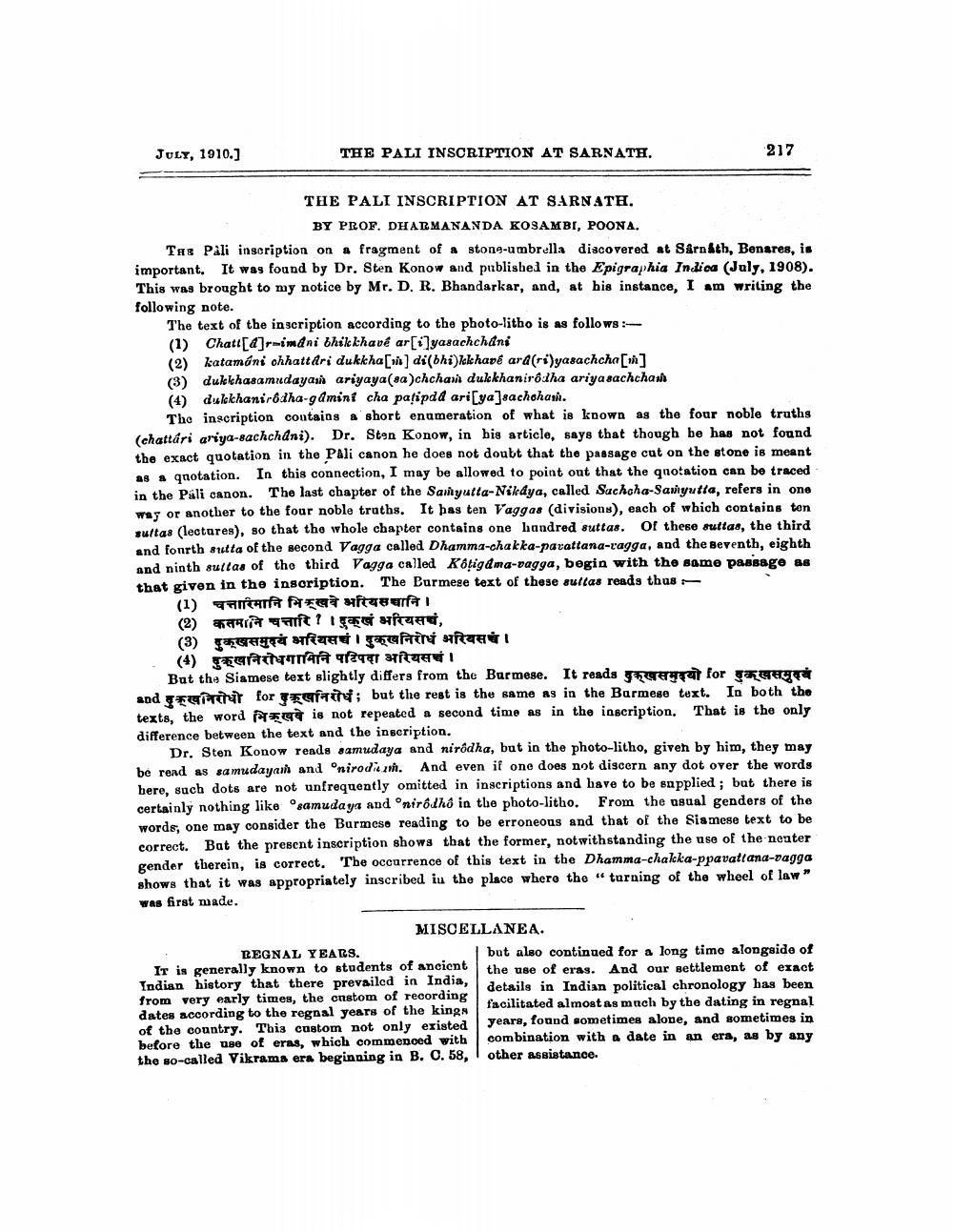________________
JULY, 1910.)
THE PALI INSCRIPTION AT SARNATH.
217
THE PALI INSCRIPTION AT SARNATH.
BY PROF. DHARMANANDA KOSAMBI, POONA. Tas Pali inscription on a fragment of a stone-umbrella discovered at Sarnath, Benares, is important. It was found by Dr. Sten Konow and published in the Epigraphia Indica (July, 1908).
This was brought to my notice by Mr. D. R. Bhandarkar, and, at his instance, I am writing the following note.
The text of the inscription according to the photo-litho is as follows : (1) Chatt[]r-imani bhikkhavé ar[1]yasachchani (2) katamáni chhattari dukkha[»] di(bhi)lck havé ara(ri)yasachcha[] (3) dukkhasamudayash ariyaya(sa)chchari dukkhanirodha ariya sachchan (4) dulekhaniraha-gamini cha palipdd ari ya]sachohast.
The inscription contains a short enumeration of what is known as the four noble truths (chattári ariya-sachchani). Dr. Sten Konow, in bis article, says that though he has not found the exact quotation in the Pali canon he does not doubt that the passage cut on the stone is meant as a quotation. In this connection, I may be allowed to point out that the quotation can be traced in the Pali canon. The last chapter of the Sanyutta-Nikdya, called Sachcha-Sanyutta, refers in one way or another to the four noble truths. It has ten Vaggas (divisions), each of which contains ten sultas (lectures), so that the whole chapter contains one handred suttas. Of these suttas, the third and fonrth sutta of the second Vagga called Dhamma-chakka-parattana-ragga, and the seventh, eighth and ninth suttas of the third Vagga called Kotigama-vagga, begin with the same passage as that given in the inscription. The Burmese text of these sultas reads thus
(1) TRATA Arantzaufar (2) raft! Igas wani, (3) दुखसमुदयं भरियसचं । दुखनिरोधं अरिबसच।
(4) arata qe apie But the Siamese text slightly differs from the Burmese. It reads
for un and Trunit for EO but the rest is the same as in the Burmese text. In both the texts, the word so is not repeated a second time as in the inscription. That is the only difference between the text and the inscription.
Dr. Sten Konow reads samudaya and nirodha, but in the photo-litho, given by him, they may be rend as samudayan and Onirodiem. And even if one does not discern any dot over the words here, such dots are not unfrequently omitted in inscriptions and have to be sapplied; but there is certainly nothing like samudaya and Onirodhô in the photo-litho. From the usual genders of the words, one may consider the Burmese reading to be erroneous and that of the Siamese text to be correct. Bat the present inscription shows that the former, notwithstanding the use of the neuter gender therein, is correct. The occurrence of this text in the Dhamma-chakka-ppavatlana-vagga shows that it was appropriately inscribed in the place whero the “ turning of the wheel of law was first made.
MISCELLANEA. REGNAL YEARS.
but also continued for a long timo alongside of IT is generally known to students of ancient
| the use of eras. And our settlement of exact
the Indian history that there prevailed in India,
details in Indian political chronology has been from very early times, the custom of recording dates according to the regnal years of the kings
facilitated almost as much by the dating in regnal of the country. This custom not only existed years, found sometimes alone, and sometimes in before the use of eras, which commenoed with combination with a date in an era, as by any the so-called Vikrama era beginning in B. 0.58, other assistance.




